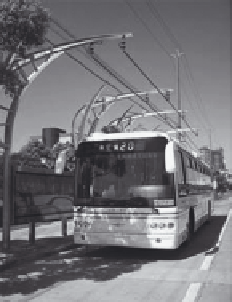Environmental Engineering Reference
In-Depth Information
Number of passengers = 41
Bus length = 12 m
Bus mass = 12.5 ton
Maximum vehicle speed = 30 mph
Air conditioning load = 15 kW
Energy consumption:
W/mi with A/C = 1,265 W/mi
W/mi without A/C = 805 W/mi
Range:
With A/C = 3.5 mi
Without A/C = 5.5 mi
Ultra-capacitor pack voltage = 700 V
dc
nominal
Charging requirement = 200 A for 3 min
Figure 2.39 Ultra-capacitor-only transit bus
converter with current regulation. The ultra-capacitor packs, typically a series
string of 15 standard 48 V modules, are charged under constant current until their
voltage reaches their rated value, at which point the charger enters constant voltage
mode. Indicators on the bus instrument panel alert the driver when charging is
complete, the pantograph is lowered and the bus resumes its route.
It is typical of 12 ton class transit buses to consume from 700 to 1,500 Wh/mi
energy. The benefit is in reduced CO
2
emissions and no pollution along the bus
routes. Operators are pleased with the quiet electric drive, passengers are impressed
with transportation without diesel fume smell and the transit authorities are pleased
with the significantly improved fuel economy and reduced maintenance.
2.7.2 Catenary powered vehicles with wayside ultra-capacitors
Potentially the greatest benefit to transportation systems when it comes to the
application of ultra-capacitors is that ultra-capacitors provide cyclable energy sto-
rage for heavy hybrids. Subway and metro-rail operators are finding that trackside,
or wayside, energy storage facilitates stabilization of the catenary, reduces the
transient burden on the power supply and improves schedules because increased
ridership has resulted in higher catenary loading, shorter headways and higher
voltage transients on the catenary.
One application of ultra-capacitors in metro-rail is the Bombardier system of
putting the RESS on the train car roof. With this system the metro is capable of
running up to 0.5 km without catenary power, crossing intersections or passing
through a tunnel. Figure 2.40 is one example of such a system.
Trackside, or wayside, energy storage technologies currently in use include
ultra-capacitor and flywheel systems. Pentadyne,
8
for example, has in production
high speed flywheel systems capable of 10 M cycles in 570-900 V applications at
1-6 MW pulse power and 5.2 MJ useable energy. Figure 2.41 illustrates a typical
trackside energy storage using flywheel modules.
8
www.pentadyne.com /uploads for reference materials on trackside flywheel energy storage.










